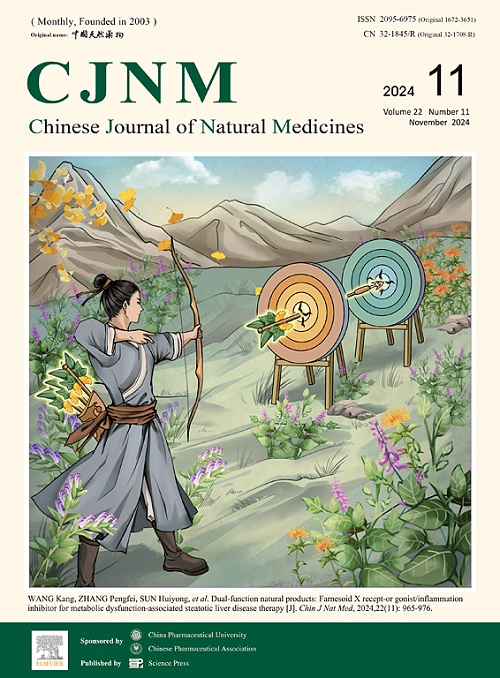Withanolide derivatives from Physalis angulata var. villosa and their cytotoxic activities
IF 4.9
2区 医学
Q1 INTEGRATIVE & COMPLEMENTARY MEDICINE
引用次数: 0
Abstract
A comprehensive phytochemical investigation of the leaves and twigs of Physalis angulata. var. villosa resulted in the isolation of 23 withanolide derivatives, including one novel 13,20-γ-lactone withanolide derivative (1) and three new withanolide derivatives (2−4). Architecturally, physalinin A (1) represents the first identified type B withanolide featuring a 13,20-γ-lactone moiety. The molecular structures of all isolates were elucidated using an integrated approach combining nuclear magnetic resonance (NMR) spectroscopy, mass spectrometry (MS), infrared (IR) spectroscopy, and quantum chemical calculations to confirm structural assignments. The antiproliferative activities of all isolated withanolides were evaluated against four human cancer cell lines (HEL, HCT-116, Colo320DM, and MDA-MB-231). Among them, eight derivatives (2, 5–8, 14, 15, and 23) exhibited significant inhibitory effects, with half-maximal inhibitory concentration (IC50) values of 0.18 ± 0.03 to 17.02 ± 0.21 μmol·L−1. Structure-activity relationship (SAR) analysis suggested that the presence of an epoxide ring enhances anticancer activity, potentially through increased reactivity or specific interactions with molecular targets involved in cancer progression. These findings underscore the pharmacological potential of withanolides as promising lead compounds for the development of novel anticancer therapeutics.
长绒Physalis varululata vlolosa .绒毛中的Withanolide衍生物及其细胞毒活性
角Physalis angulata叶片和细枝的植物化学研究。从Var. villosa中分离得到23个withanolide衍生物,包括1个新的13,20-γ-内酯withanolide衍生物(1)和3个新的withanolide衍生物(2−4)。在结构上,physalinin A(1)代表了第一个被鉴定的B型withanolide,具有13,20-γ-内酯片段。采用核磁共振(NMR)、质谱(MS)、红外(IR)光谱和量子化学计算相结合的方法对所有分离物的分子结构进行了鉴定。对提取的四种人癌细胞(HEL、HCT-116、Colo320DM和MDA-MB-231)的抗增殖活性进行了评价。其中,8个衍生物(2、5-8、14、15和23)表现出显著的抑制作用,半数最大抑制浓度(IC50)值为0.18±0.03 ~ 17.02±0.21 μmol·L−1。构效关系(SAR)分析表明,环氧环的存在增强了抗癌活性,可能是通过增加反应性或与参与癌症进展的分子靶点的特异性相互作用。这些发现强调了作为开发新型抗癌治疗药物的先导化合物的药物潜力。
本文章由计算机程序翻译,如有差异,请以英文原文为准。
求助全文
约1分钟内获得全文
求助全文
来源期刊

Chinese Journal of Natural Medicines
INTEGRATIVE & COMPLEMENTARY MEDICINE-PHARMACOLOGY & PHARMACY
CiteScore
7.50
自引率
4.30%
发文量
2235
期刊介绍:
The Chinese Journal of Natural Medicines (CJNM), founded and sponsored in May 2003 by China Pharmaceutical University and the Chinese Pharmaceutical Association, is devoted to communication among pharmaceutical and medical scientists interested in the advancement of Traditional Chinese Medicines (TCM). CJNM publishes articles relating to a broad spectrum of bioactive natural products, leading compounds and medicines derived from Traditional Chinese Medicines (TCM).
Topics covered by the journal are: Resources of Traditional Chinese Medicines; Interaction and complexity of prescription; Natural Products Chemistry (including structure modification, semi-and total synthesis, bio-transformation); Pharmacology of natural products and prescription (including pharmacokinetics and toxicology); Pharmaceutics and Analytical Methods of natural products.
 求助内容:
求助内容: 应助结果提醒方式:
应助结果提醒方式:


